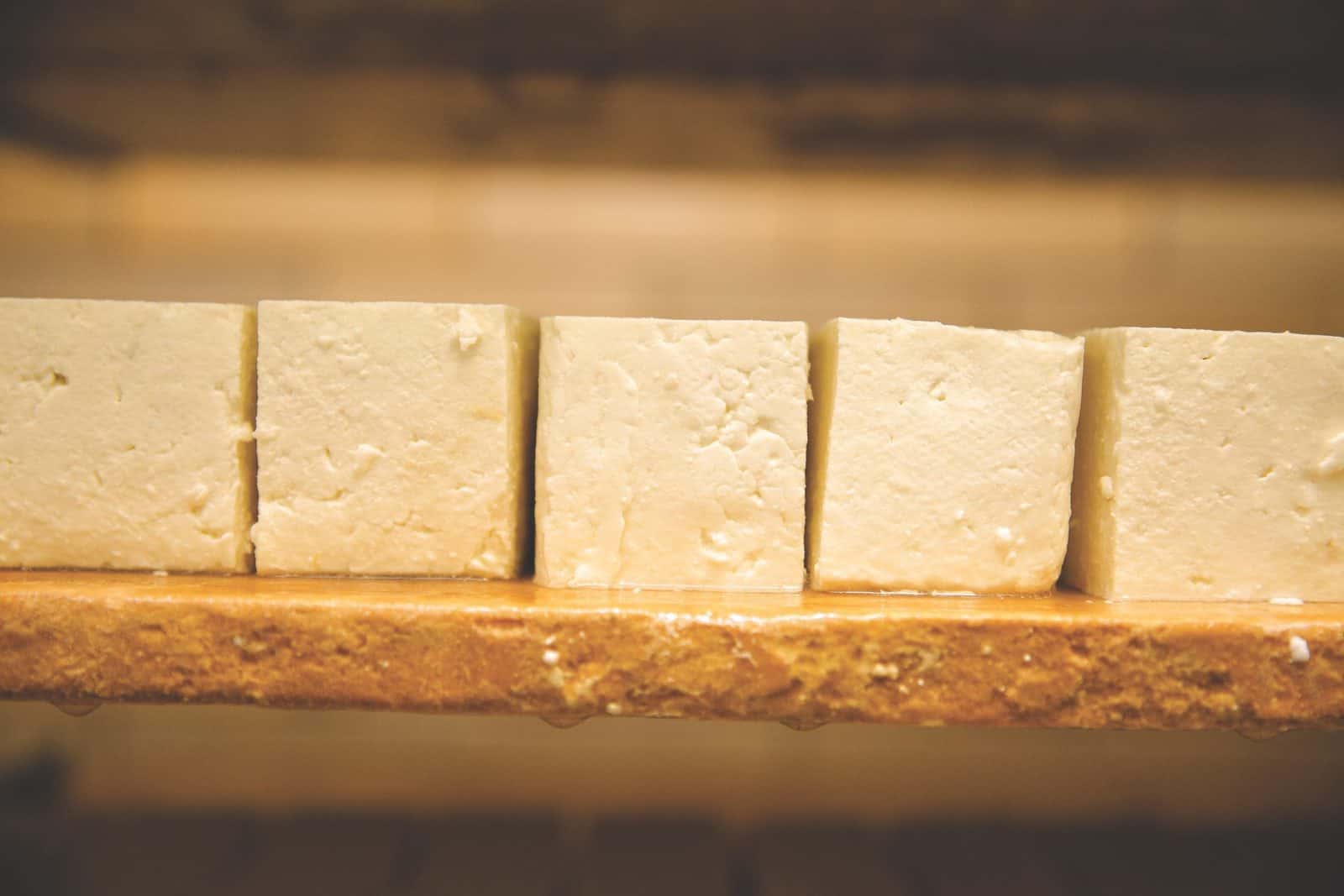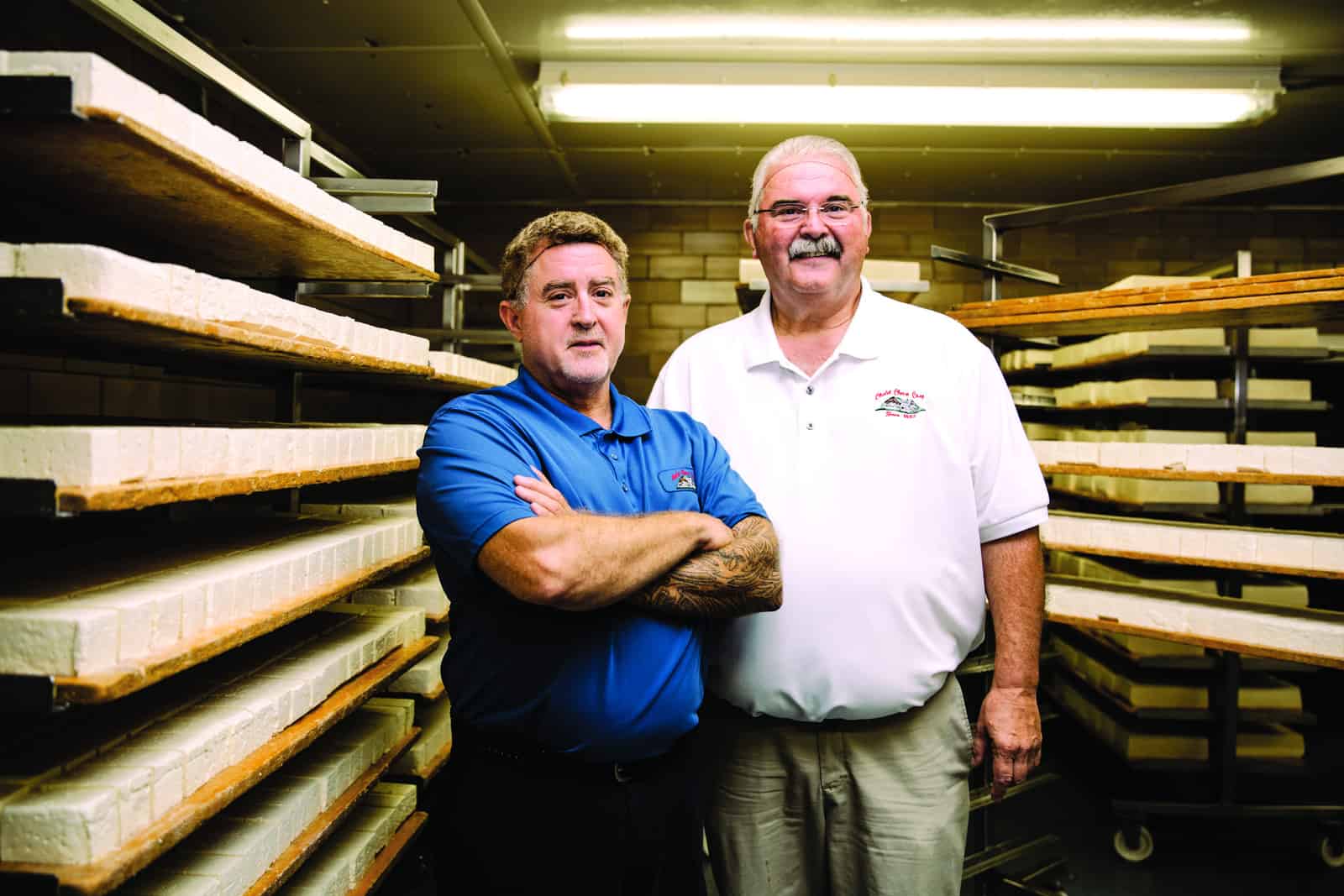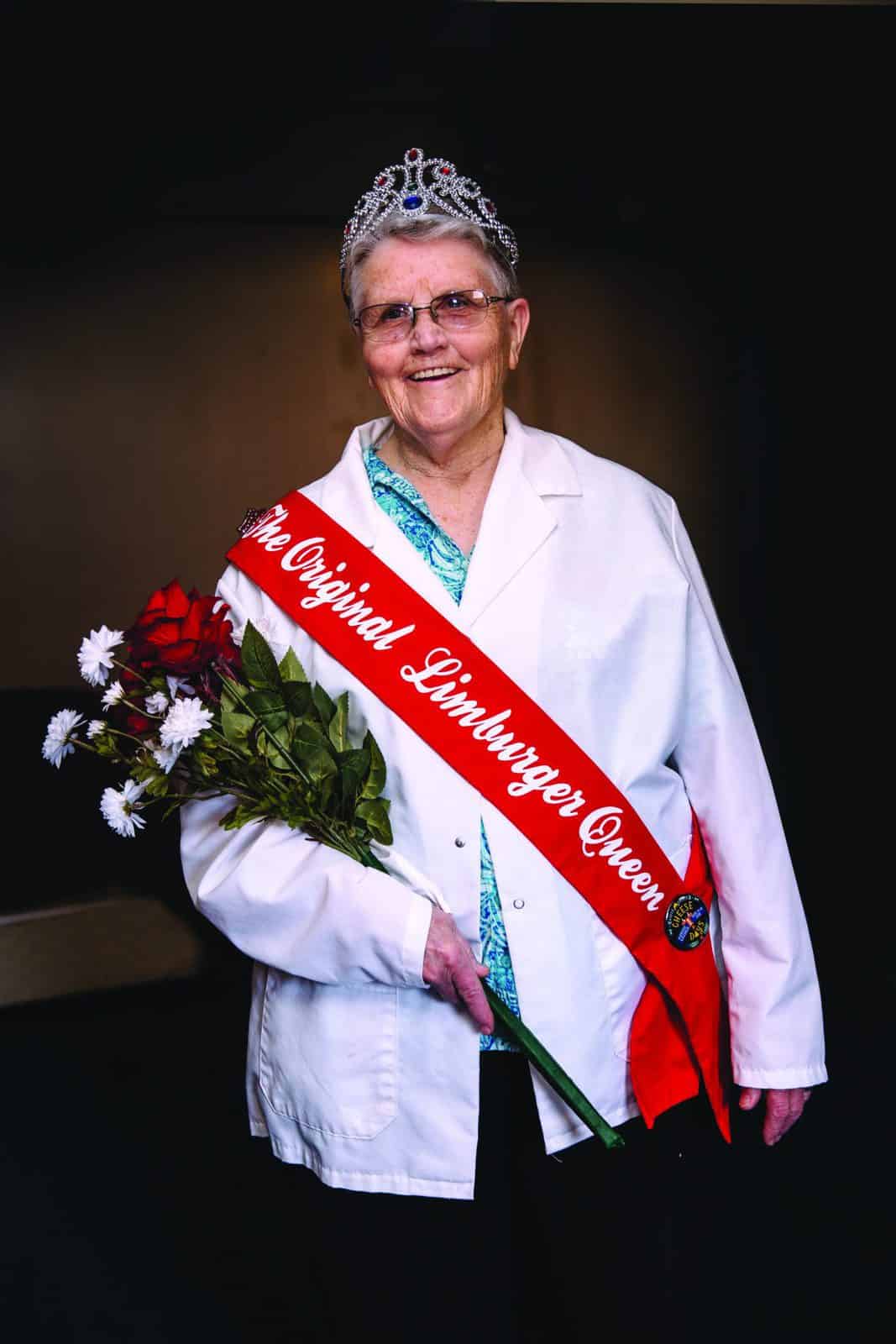
At Baumgartner’s Tavern in Monroe, Wis., there’s a sandwich that makes out-of-towners recoil in fear. On the painted menu strung above the bar, wedged between humdrum items like “Sloppy Chili Dog” and “Old-Fashioned Soup,” its name would be easy to miss—if not for the ruckus it incites.
“Limburger.” A name steeped in memory and meaning; a word that elicits a visceral response. Sitting incognito at the far end of the bar, I watch the drama unfold. Three women visiting from Milwaukee dare one another to try the famous menu item: thick pieces of limburger cheese and raw red onion between slices of rye bread. The bravest one volunteers. She pinches her nose shut in preparation. Her friends look on, eyes wide with cringe and curiosity.
Surely, they’ve heard the stories. The rumors of wedding pranksters who smear limburger cheese atop a honeymoon car’s engine, sending an assaulting aroma through the vehicle as the newlyweds drive away. Maybe they read The Invalid’s Story by Mark Twain, in which two men mistake a box of limburger for a decaying corpse. Perhaps they remember seeing The Three Stooges faint over a whiff of the cheese, or they watched Charlie Chaplin toss it into enemy trenches in Shoulder Arms, its stink compelling surrender. Whatever they’ve heard, limburger’s reputation precedes it. The brave tourist closes her eyes and takes a bite.
Monroe’s Stalwart
Limburger’s far-flung infamy belies its humble origins. The next morning, just down the road at the Chalet Cheese Cooperative, a genteel local named Myron Olson shows me how he makes Country Castle Limburger: the way he learned to 48 years ago when he was in high school. A few mornings each week, he fills an open vat with milk, transforms it into curd, and pumps it onto a rectangular, cheesecloth-covered table, forming a slab that is cut into 70 blocks.
After salting the young limburgers, he hauls them into an aging cave thick with humid air and places them on pine shelves. A small metal bucket sits adjacent, filled with a frothy concoction: the brine. A heady mix of salt water and ripening bacteria, it’s used to wash the limburgers twice during their first week of aging, rendering them rosy and slightly ripe.
Soon the blocks will be wrapped in foil and transferred to a cooling room, where they’ll transform from salty and feta-like to creamy and luscious over a few months. Meanwhile, before the pine boards are washed, the remnants of rind remaining on the wood are scraped off into a fresh saltwater bucket, inoculating a new batch of brine. That process propagates the same bacterial cultures that have been used to make limburger at Chalet Cheese—Wisconsin’s oldest cooperative dairy—for over a hundred years.
“It used to be that this room was full of ’em,” Olson says of the pine shelves as we stand in the cave. He points to an empty corner on the opposite side of the room. “The shelves went all the way to there—there was just enough room for us to get by. That’s how much limburger we used to go through.”
Suddenly, the room feels very empty: These few shelves represent all that remains of an iconic cheese that was once among the most popular in the US. And in just a few weeks, Olson, the country’s only Master Cheesemaker specialized in limburger, will be retiring. What will happen to the last limburger in America?

Young blocks of limburger age on pine shelves at Chalet Cheese.
New Kid on the Block
Limburger first popped up in Wisconsin following a wave of immigration in the late 1800s. Originally a Belgian cheese, it had been replicated and popularized in Germany; here in Green County, it was reinvented anew.
In an area heavily populated with newcomers from Germany and Switzerland, limburger became a universal rendering of a common homeland tradition: the washed-rind wheel of wintertime. Just as with European classics like Vacherin Mont d’Or and Reblochon, it was born of practicality. In winter, milk was scarce and fatty; large Alpine-style wheels were less practical. And so when Green County farmers weren’t making Swiss cheese, they made limburger. They ate it for breakfast on toast, dolloped with strawberry jam or honey; they wedged it into a rye-and-onion sandwich and washed it down with beer at the tavern. It was inexpensive and abundant. It was the workingman’s cheese.
Founded as the Swiss Cheese Factory by a group of five Green County dairy farmers in 1885, the Chalet Cheese Cooperative rode the coattails of that New World limburger craze. As immigrant communities expanded throughout the eastern United States, precipitating demand, the cooperative—along with many neighbor dairies—grew to meet it. In 1926, 98 percent of limburger made in Wisconsin was made in Green County; by 1935, almost 7 million pounds of limburger was being made in Wisconsin. To transport the scads of washed-rind blocks from these rolling green hills to nearby cities, a local train line was established—the Milwaukee 508, nicknamed “The Limburger Special.”
By the 1920s, even the Kraft brothers—German descendants who began their dairy empire as a Chicago cheese distribution company—were on board. They teamed up with Chalet Cheese to distribute limburger, fueling the cooperative’s continued growth. Olson, a local kid who grew up on a dairy farm, began working at the factory in 1970 to save money for college. “I’d come over after school, wrap limburger, and go home at nine o’clock at night,” he remembers. In college, he studied cheesemaking and earned his limburger license. He returned to Chalet Cheese during its mid-70s prime, when the factory was turning out two million pounds of limburger per year.

Cheesemaker Myron Olson (right) will soon pass the torch to Jamie Fahrney (left).
Tough Times
Yet even when those pine shelves, rye sandwiches, and freight cars overflowed with a bounty of limburger cheese, not everything was coming up roses for the rubicund block. From malignment in pop culture to political controversy, limburger couldn’t catch a break.
As early as 1885, Monroe-based politician Lohn Luschinger described 25 nearby cheese factories producing “a premeditated outrage on upon the organs of smell”; around the same time, Mark Twain called the cheese’s aroma “most evil.” In 1902 in Louisville, Ky., a ban on all Limburger cheese was declared. Calling it “unwholesome” and citing its “many microbes,” local health officer Dr. M. K. Allen equated the cheese with a fetish for “animal life.” (Allen quickly clarified that this affinity only existed among “some people”; a group of local Germans soon protested the order to no avail).
Some years later in Iowa, a mailman was overcome with the smell of a limburger-filled parcel; the local postmaster, citing a rule against “objectionable” scents, soon banned all shipments of the cheese. “Limburger: Fragrant in Monroe; Putrid in Iowa,” read a headline in the Milwaukee Journal. Putrid, unwholesome, objectionable, evil: Were these caustic descriptors mere tasting notes—or did they also reek of skepticism toward the immigrants and working-class taverngoers who so loved the cheese?
Either way, it was not a good time to be pungent in America. By the mid-20th century, the refrigeration era arrived in full force. In gleaming kitchens, foods were hidden from sight and smell; cleaning products waged war against microbes. Cunning cheese companies adapted. Mild wedges appealed to modern sensibilities and were cheaper to produce. American cheese was born. “Cheese with flavor went out of style,” Olson says.
Starting in the mid-1940s, limburger production in the United States embarked on a steady decline. Between 1950 and 1960, the number of limburger plants in the country dropped by two-thirds; by the early 1980s, there was only one left: the Chalet Cheese Cooperative. In addition to cornering 100 percent of the remaining US limburger market—which has now dwindled to less than 500,000 pounds—the co-op has survived by producing a range of other sought-after cheeses, from Wisconsin brick to an award-winning baby Swiss.
Keeping it Real
Looking back at Limburger’s rise and fall, Olson can’t shake a sense of irony. About 14 years ago, Kraft completed its pivot toward bland, processed cheeses with its very last order for Chalet Cheese’s limburger, ending 70 years of collaboration. But soon after, artisan washed rind cheeses began popping up on the market. “People still wanted their stinky cheese,” Olson says, “but they had to go to a different source.”
Sticky, orange, and pungent, today’s washed rinds have a different reputation. They win awards. They’re tucked into precious packaging and boast high price tags. “When I say ‘limburger,’ right away people say ‘No, no, I’ve heard the stories, I don’t want to try it,’” says Olson. “But if I gave them that same piece and said, ‘This is Saint Michael’s reserve, specially washed, specially cured just for you,’ would they try it? ‘Oh sure, let me try it, it smells, but it’s really got a good flavor.’”
It might be wrapped in foil packaging that hasn’t changed in decades, but like the trendiest washed-rind wheels, limburger is an artisanal cheese. “This is the old standby, the open vat,” Olson explains as we stroll through the facility, which is still cooperatively owned by a group of 16 farmers. “Nowadays [many cheesemakers] use vats that are closed, that are mechanized; they make good cheese, but not the old-fashioned way.”
Perhaps nothing is more “old fashioned” than that bubbling bucket of brine, teeming with cultures propagated at the dairy since 1911. It was nearly lost in 1947, when Chalet Cheese moved from its original plant to its current location. Built with investment from Kraft, this dairy was supposed to be the most modern limburger plant in America—right down to its brand new ripening cultures and sparkling clean aging planks.
But there was a problem. “The first month all they had was green moldy cheese,” Olson says. While the green limburger stumped proponents of the modern factory, the manager at the time, a Swiss native named Albert Deppeler, had a hunch: Maybe the sanitized factory was too modern. He schlepped down the hill to grab the old factory’s wooden boards and decades-old schmear, and brought them to the facility. Within a month, the new factory was turning out authentic, rosy-hued limburger: a testament to the cheese’s tradition and terroir.
Tried and True
Then there’s the matter of flavor. Back at Baumgartner’s Tavern, the brave Milwaukee tourist washes her bite down with a beer and reassures her friends: It’s not so bad. Bartender C.J. Kindschi tells me that at least half of first-timers are pleasantly surprised. “The legend is a lot worse,” he says, standing beneath a tin sign that reads: “Limburger: Don’t eat it with your nose.” Indeed, the blocks are creamy, rich, and robust, savory and with a mild pungency that increases slightly with time.
If limburger were on the brink of extinction, you wouldn’t know it at Baumgartner’s. Sure, brave tourists order it on a dare—but local regulars also head to the tavern for a limburger sandwich and a beer, as they have since the 1800s. “It’s definitely one of our more popular menu items,” Kindschi says. “Maybe because there aren’t that many places you can get a limburger sandwich.” (The only other he knows of is Swiss Haus, just down the street.)

Carol Tourdot, aka “The Limburger Queen,” has been affixing labels to limburgers at Chalet for 42 years. Here, she dons her garb for the Green County Cheese Days festival.
Here the cheese is a source of local pride. During the town’s biennial cheese festival, a “Limburger Queen” parades down the street to much fanfare, while food stalls sling limburger sliders and limburger T-shirts fly off the shelves in the swag tent. At the National Historic Cheesemaking Center a few blocks away, Chuck Ekena, a retired schoolteacher and volunteer in the on-site museum, shows me an entire exhibit wall devoted to the cheese, replete with a list of “Positive Points about Limburger.” “Limburger? That’s good stuff,” Ekena says. “But I have to go to Baumgartner’s to eat it, because my wife won’t let me bring it home.”
Indeed, it’s still the butt of a joke—but boosted by a mix of nostalgia and steadfast loyalty, limburger lives on. “Even though production is a fraction of what it once was,” says Suzanne Isige, market research manager at the Dairy Farmers of Wisconsin, “we still get the occasional call from someone trying to track down the limburger cheese their dad or grandad used to enjoy.”
“We like to say we’re the granddad of stinky cheese—we’ve been here forever,” Olson says proudly after introducing me to Jamie Fahrney, his soon-to-be replacement. Fahrney, a Master Cheesemaker certified in baby Swiss who has been working alongside Olson at Chalet Cheese for 40 years, says the move to overseeing limburger “is just a natural step.” He sees distribution as a challenge for limburger, but isn’t too worried about decreased demand. “I don’t see it declining—hopefully it will increase,” he says.
“The desire is there,” Olson says, nodding in agreement. Indeed, when I ask him to describe his average consumer, he sums it up: “Oh, they’re probably 76 years old,” he says. “But they’d swim a river and climb a mountain to get their limburger.”



